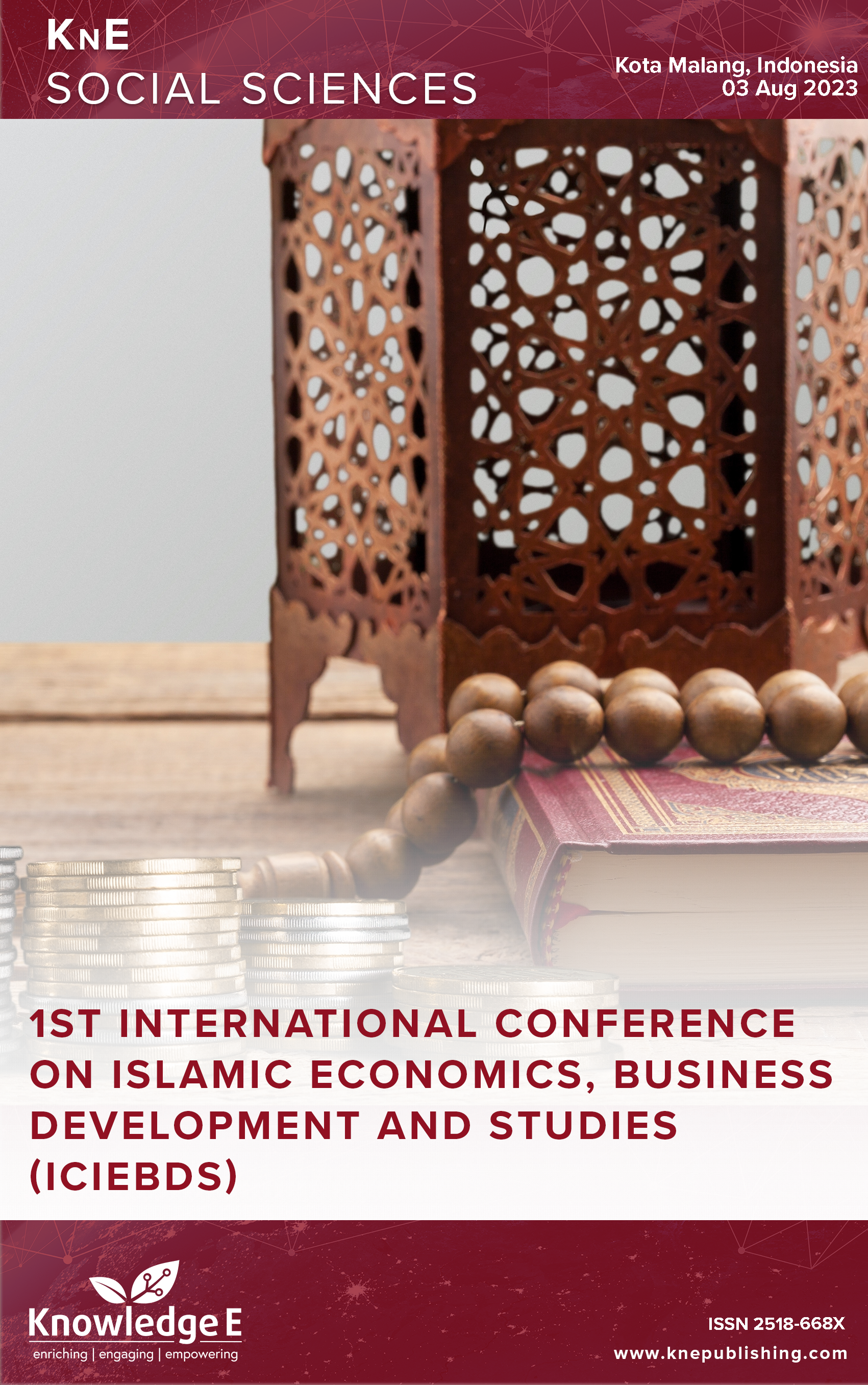Analysis of the Effect of Temporary Syirkah Funds and Operational Efficiency on Profitability with NPF as a Moderating Variable (Study on Islamic Commercial Banks 2017-2022)
DOI:
https://doi.org/10.18502/kss.v9i16.16287Abstract
This study aims to examine the effect of Temporary Syirkah Funds and Operational Efficiency on Profitability with NPF as a moderating variable. This study uses a type of quantitative research with a causal associative approach. The sampling technique used purposive sampling so that it was collected by 8 Sharia commercial banks. Data is obtained secondary through annual reports published on the website of each bank for 2017-2022. This study uses hypothesis testing using multiple linear regression testing tools. Data is processed using the Eviews-10 software application. The results showed that temporary syirkah funds had a positive and significant effect on profitability, operational efficiency did not affect profitability, Non-Performing Finance (NPF) was able to moderate the effect of temporary syirkah funds on profitability, Non-Performing Finance (NPF) was unable to moderate the effect of operational efficiency on profitability in Islamic commercial banks.
Keywords: temporary syirkah fund, operational efficiency, profitability, non-performing finance
References
A. Syukron, “Dinamika perkembangan perbankan syariah di Indonesia,” Econ. J. Econ. Islam. Law, vol. 3, no. 2, pp. 28–53, 2013.
S. Hanum, “Analysis of Inventory Turnover and Debt to Equity Ratio in Increasing Profitability in PT. Nusantara IV Plantations, Medan,” in Journal of International Conference Proceedings, 2021, vol. 4, no. 2, pp. 518–527. DOI: https://doi.org/10.32535/jicp.v4i2.1285
M. Noval and L. Aisyah, “Analisis Pengaruh Dana Syirkah Temporer dan Efisiensi Operasi Terhadap Profitabilitas Bank Syariah,” J. Ilm. Ekon. Islam, vol. 7, no. 1, pp. 113–122, 2021. DOI: https://doi.org/10.29040/jiei.v7i1.1640
P. Maulana, S. Dwita, and N. Helmayunita, “Pengaruh CAR, NPL, LDR dan BOPO Terhadap Return ON Assets (ROA) pada Bank yang Terdaftar di Bursa Efek Indonesia Tahun 2017-2019,” J. Eksplor. Akunt., vol. 3, no. 2, pp. 316–328, 2021. DOI: https://doi.org/10.24036/jea.v3i2.355
V. W. Sujarweni and L. R. Utami, “Analisis dampak pembiayaan dana bergulir KUR (Kredit Usaha Rakyat) terhadap kinerja UMKM (Studi kasus di Daerah Istimewa Yogyakarta),” J. Bisnis dan Ekon., vol. 22, no. 1, 2015.
F. D. Davis, “Perceived Usefulness, Perceived Ease of Use, and User Acceptance of Information Technology,” MIS Q., vol. 13, no. 3, Sep. 1989. DOI: https://doi.org/10.2307/249008
A. M. NURBAITI and M. I. Fasa, “Peran Perbankan Syariah Dalam Membantu Usaha Mikro Kecil Dan Menengah Menerapkan Konsistensi Pencatataan,” Revenue J. Ekon. Pembang. dan Ekon. Islam, vol. 4, no. 01, pp. 1–13, 2021. DOI: https://doi.org/10.56998/jr.v4i01.30
I. Fahmi, Analisis Kinerja Keuangan. Bandung: Alfabeta, 2012.
S. SUHENDI, “ANALISIS KINERJA KEUANGAN PT. WIJAYA KARYA, Tbk SEBELUM DAN SESUDAH GO PUBLIC (Studi Kasus Pada PT. Wijaya Karya, Tbk).” Universitas Mercu Buana Jakarta, 2016.
J. Dkk, Jurus Jitu Pendidik pada Pelaksanaan Daring. tulungagung: Akademia Pustaka, 2021.
S. Riyadi and A. Yulianto, “Pengaruh pembiayaan bagi hasil, pembiayaan jual beli, Financing to Deposit Ratio (FDR) dan Non Performing Financing (NPF) terhadap profitabilitas bank umum syariah di Indonesia,” Account. Anal. J., vol. 3, no. 4, 2014.
A. R. Rivai and W. Wahyudi, “The effort to create customer engagement on customer e_banking (empirical studies on Bank BNI regional Semarang),” JDM (Jurnal Din. Manajemen), vol. 7, no. 2, pp. 191–205, 2016. DOI: https://doi.org/10.15294/jdm.v7i2.8202
B. Hananto and S. Amijaya, “Pengaruh Ukuran Perusahaan, Ratio Kecukupan Modal, Dana Syirkah Temporer, dan BOPO Terhadap Profitabilitas Bank Syariah Di Indonesia,” J. Ekon. Syariah Pelita Bangsa, vol. 6, no. 02, pp. 138–151, 2021. DOI: https://doi.org/10.37366/jespb.v6i02.243
L. Fadlilah, “Pengaruh Liabilitas, Ekuitas, dan Dana Syirkah Temporer Terhadap Profitabilitas Dengan Risiko Pembiayaan Sebagai Variabel Intervening Pada Bank Umum Syariah di Indonesia (Periode 2016-2020),” 2022.
N. Rahmi, “Pengaruh CAR, BOPO, NPF, dan CSR Disclosure terhadap Profitabilitas Perbankan Syariah.” UNIVERSITAS NEGERI JAKARTA, 2013.
R. S. Ariani, “Pengaruh Dana Pihak Ketiga (DPK), Financing to Deposit Ratio (FDR), Non Performing Financing (NPF), dan Returm On Asset (ROA) Terhadap Total Aset Perbankan Syariah di Indonesia Periode 2016-2020,” 2021. DOI: https://doi.org/10.21154/etihad.v2i1.3958
M. Marheni, “Peningkatan Profitabilitas Serta Pengaruh Dana Syirkah Temporer, Kewajiban Dan Ekuitas Dengan Variabel Risiko Pembiayaan Sebagai Antiseden (Studi Pada Perbankan Syariah Di Indonesia),” ASY SYAR’IYYAH J. ILMU SYARI’AH DAN Perbank. Islam, vol. 1, no. 1, pp. 144–172, 2016. DOI: https://doi.org/10.32923/asy.v1i1.669
E. T. Dewi and W. Srihandoko, “Pengaruh Risiko Kredit dan Risiko Likuiditas Terhadap Profitabilitas Bank,” J. Ilm. Manaj. Kesatuan, vol. 6, no. 3, pp. 131–138, 2018. DOI: https://doi.org/10.37641/jimkes.v6i3.294
M. Yusuf and S. Surjaatmadja, “Analysis of financial performance on profitability with non performance financing as variable moderation (study at Sharia commercial bank in Indonesia period 2012–2016),” Int. J. Econ. Financ. Issues, vol. 8, no. 4, pp. 126– 132, 2018.
A. Simatupang and D. Franzlay, “Capital adequacy ratio (CAR), non performing financing (NPF), efisiensi operasional (BOPO) dan financing to deposit ratio (FDR) terhadap profitabilitas bank umum syariah di Indonesia,” J. Adm. Kant., vol. 4, no. 2, pp. 466–485, 2016.
S. Sugiyono, Metode Penelitian Bisnis. Bandung: CV. Alpabeta, 2012.
N. Aisyah and M. Munardi, “DETERMINASI DANA SYIRKAH TEMPORER TERHADAP BAGI HASIL PADA PT. BANK BRI SYARIAH,” J. Ekon. Indones., vol. 9, no. 2, pp. 19–25, 2020. DOI: https://doi.org/10.29103/ekonomika.v9i2.3180
A. Y. Nugroho and F. R. F. Rachmaniyah, “Pengaruh LDR, NIM, NPL dan BOPO terhadap Harga Saham pada PT. Bank Rakyat Indonesia, Tbk 2017-2019,” J. Kop. dan Manaj., vol. 1, no. 01, pp. 28–43, 2020.
L. Barus, “Analisis Faktor-faktor yang mempengaruhi Profitabilitas Pada Perusahaan anufaktur yang Terdaftar di Bursa Efek Indonesia,” J. Wira Ekon. Mikroskil, vol. 3, no. 02, 2013. DOI: https://doi.org/10.55601/jwem.v3i2.207
M. Handayani, M. R. Rianto, A. Sulistyowati, and S. Supriyanto, “Pengaruh NPF, BOPO, Inflasi dan Nilai Tukar Terhadap Kinerja (ROA) pada Bank Umum Syariah Masa Pandemi Covid 19,” J. Ilm. Ekon. Islam, vol. 8, no. 2, pp. 1887–1894, 2022.
A. Anwar and S. Malik, “Cogitating the role of technological innovation and institutional quality on environmental degradation in G-7 countries,” Int. J. Green Econ., vol. 15, no. 3, pp. 213–232, 2021. DOI: https://doi.org/10.1504/IJGE.2021.120871
L. Dendawijaya, “Manajemen Perbankan Edisi 2,” Bogor Ghalia Indones., 2005.

